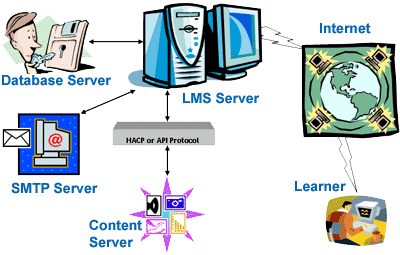LMS Architecture |
||
| Learning Management System Server | ||
The Learning Management Server (LMS Server) is the central functional component of the LMS . The LMS Server enables the configuration and coordination with the other components of the system . You can deploy a single LMS Server or you can create a cluster of LMS Servers to improve performance and availability. Each server in the cluster contains the same L M S files and data. |
 |
|
Administrators, Mentors and learners - all have access to portions of the LMS Server’s functionality. For administrators, the LMS Server provides the ability to manage courses, create course catalogs, manage learners and resources, and create reports and to manage the settings of LMS and the other components. Learners can use the LMS Server to access online resources. |
||
| Relational database management system (Database Server) | ||
The RDBMS software can reside on the same machine as the LMS software for a
small implementation, but it usually resides on one or more separate machines
for performance reasons.
The LMS Server uses relational databases to store information about users,
courses, the catalog and other settings needed to run the LMS. When users use
the LMS, the LMS Server initiates database transactions to retrieve and update
information. |
||
| Content server | ||
The Content server contains the contents (courses and other learning
resources) after they are imported into the LMS. In most cases, the Content
server is an HTTP server. It is possible to have multiple Content servers, and
can also be clustered. |
||
| SMTP server | ||
SMTP server enables LMS to communicate various users via emails. This is used
for all notifications, reminders, automated reports, helpdesk etc. |
||